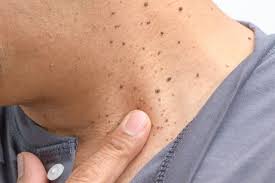Skin tags are soft, flesh-colored growths that develop on the skin. They are common, small, and generally harmless.

How to identify a skin tag
Tissue marks typically match your skin tone or may be slightly darker. They often appear to be hanging off the skin. Usually, they are painless and benign.
They commonly form in areas where skin rubs against itself, such as:
– The neck
– Under the arms
– Eyelids
– Under the breasts
– Around the bottom
Tissue marks vary in size, ranging from 2mm to 5cm. You may develop a single tag or several in one area.
For a visual reference, you can see:
– A single skin tag on dark brown skin (Credit: GIRAND/BSIP/SCIENCE PHOTO LIBRARY)
– Multiple skin tags on a person with light brown skin (Credit: Kwanchai Chai-udom / Alamy Stock Photo)
Differences between skin tags, warts, and moles
– Warts often appear on hands and feet, are raised, and have a rough texture.
– Moles are usually found in sun-exposed areas and vary in color (pink, light brown, dark brown). They are typically flat and round or oval.
When to see a doctor
You should consult a GP if a skin tag:
– Increases in size
– Becomes painful
– Starts to bleed
– Multiplies quickly
Treatment options
While skin tags don’t need removal, they can be removed if bothersome through:
– Heat treatment
– Freezing
– Surgical removal
Once removed, skin tags usually don’t return, but scarring or dark spots may temporarily appear, especially in people with black or brown skin.
Note: Skin tag removal is considered a cosmetic procedure and is not covered by the NHS, so you may need to pay for the service.
Important safety note
Avoid removing a skin tag yourself unless advised by a doctor. Risks include infection, bleeding, and scarring.
Causes
The exact cause of skin tags isn’t fully understood, but they are often linked to skin friction. Factors that may increase the likelihood of developing skin tags include:
– Obesity or skin folds
– Type 2 diabetes
– Hormonal changes during pregnancy



























